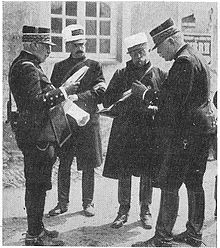André Sordet
Jean-François André Sordet (* 17th May 1852 in Saint-Germain-du-Plain , Saône-et-Loire ; † 28. July 1923 ) was a French officer who last Général de division , which at the beginning of World War I a after him named cavalry corps in Belgium and on the retreat to the Marne .
Life
Sordet fought as a young infantry officer in the Franco-Prussian War of 1870/71 and only then came to the Saint-Cyr military school , after which he chose the cavalry as a branch of service. He came to the 14e régiment de chasseurs and from 1882 attended the École d'application de la cavalerie in Saumur . This was followed by uses in various Jäger and Dragoon regiments. In 1898 he became a colonel and commander of the 23e régiment de dragons .
Promoted to Général de brigade in 1903 , he received command of the 3e brigade de dragons and in 1907 of the 5e division de cavalerie . In 1910 he moved to the 4th division de cavalerie in the same position . From May 1912 he led the Xth Army Corps, based in Rennes, for a year . He then became inspector general of the cavalry and a member of the Conseil supérieur de la guerre .
At the beginning of World War I, Sordet was given command of a newly formed cavalry corps, commonly referred to as Corps Sordet, which comprised three cavalry divisions. It was supposed to operate on the left flank of the French 5th Army ( Charles Lanrezac ) and to scout across the Belgian border. Proceeding along the Meuse from August 5th , the corps reached the Liege area , which was besieged by the Germans, within three days , covering a distance of 180 kilometers. Building a fan to the west of Charleroi , the corps saw no signs of a German advance across Belgium. This can be explained by the fact that the German army was still standing en masse on the border, waiting for the capture of Liège. On August 15, German troops began to cross the Meuse en masse and Sordet attempted a flank attack before retreating west and positioning themselves northwest of Dinant . On August 17th he was ordered north to the Sambre by the High Command , but delayed the movement of the troops because of the exhaustion of the horses and riders in order to give them a break.
His main task now was to shield the gap between the left flank of the 5th Army and the British Expeditionary Force, which had now landed . Parts of the corps were involved in the battles on the Sambre and Mons . There were communication difficulties with the British allies, which may have led to the decision to retreat across the border. Ordered to the left flank of the BEF and with additional tasks such as support for the garrison of Lille , where a Division Group under Albert d'Amade held, loaded, Sordet could do little to the British in the Battle of Le Cateau to support and withdrew, possibly prematurely, to the south.
Assigned to Joseph Maunoury's 6th Army on August 30th, Sordet's Corps supported their retreat across the Avre . During the Battle of the Marne , Sordet tried to threaten the right rear flank of the German 1st Army with his corps, which had been refreshed in the meantime . However, Joffre, not convinced that the rest was sufficient, dismissed Sordet on September 8 and replaced him with General Bridoux . Sordet is one of the more than 50 generals Joffre dismissed in the first weeks of the war.
Unlike most of them, Sordet was soon given a new position as inspector general of the cavalry depots in the combat zone and in the hinterland, initially in Orléans and later in Paris . In early 1917 he was released from active duty and assigned to the reserve. In 1923 his work Historique du Corps de Cavalerie Sordet appeared on the events of 1914. Sordet died in the same year at the age of 71.
The journalist, music critic and collaborator in World War II Dominique Sordet was his son.
literature
- Barbara Tuchman: The Guns of August. Random House, 1962.
Web links
- Dossier with documents on the website of the French Ministry of Culture
| personal data | |
|---|---|
| SURNAME | Sordet, André |
| ALTERNATIVE NAMES | Sordet, Jean-François André (full name) |
| BRIEF DESCRIPTION | French general |
| DATE OF BIRTH | May 17, 1852 |
| PLACE OF BIRTH | Saint-Germain-du-Plain , Saône-et-Loire department |
| DATE OF DEATH | July 28, 1923 |

